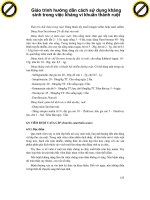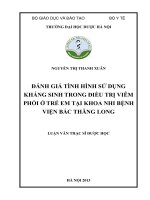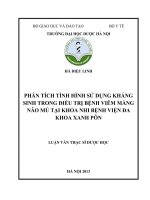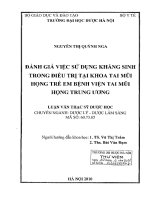Cách sử dụng kháng sinh trong nhi khoa
Bạn đang xem bản rút gọn của tài liệu. Xem và tải ngay bản đầy đủ của tài liệu tại đây (1.62 MB, 38 trang )
PGS.TS Phạm Nhật An
Nhắc lại được các kiến thức cơ bản về KS và
các nhóm kháng sinh, nguyên tắc cơ bản “sử
dụng KS hợp lý”
Nắm vững chỉ định và nguyên tắc lựa chọn KS
cho trẻ em, các cách tính liều lượng thuốc,
đường dùng… các tai biến, tác dụng phụ của
KS cho TE
Cập nhật vấn đề áp dụng kháng sinh điều trị
những bệnh nhiễm trùng hay gặp trong Nhi
khoa
M ột s ố khái ni ệm
Điều trị:
-
Dùng thuốc
Không dùng thuốc
Kết hợp
Điều trị toàn diện (Comprehensive Treatment)
Quản lý thuốc điều trị(Medication therapy
management)
Nh ững chú ý khi dùng thu ốc
cho tr ẻ em
Chỉ định đúng, liều lượng đúng…
Chọn loại thuốc, dạng bào chế thích hợp
Đường dùng thích hợp
TM? Bắp? Uống? Sonde dạ dày? Dưới da?
Đường HM? Bôi? Tra? Khí dung?....
Kỹ thuật áp dụng:
- Dùng lúc no? Đói? Sốt? Tiêu chảy?
- TS Dị ứng?...
Kháng sinh là những chất do vi sinh vật tiết ra hoặc
những hoạt chất hóa học bán tổng hợp, tổng hợp có
khả năng đặc hiệu kìm hãm sự phát triển hoặc tiêu diệt
được các vi sinh vật khác với nồng độ rất thấp
“ A drug used to treat infections caused by bacteria
and other microorganisms. Originally, an antibiotic
was a substance produced by one microorganism
that selectively inhibits the growth of another.
Synthetic antibiotics, usually chemically related to
natural antibiotics, have since been produced that
accomplish comparable tasks."
Antibacterial
Antifungal
Antimycobacterial
Antiparasitic
Antiviral
Biological Hep B-Hyperimmune globulin
Intravenous immune globulinPalivizumab
Rabies- Hyper immune globulin
Tetanus- Hyperimmune globulin
VIG (Vaccinia Immune Globulin)
-
Đặc điểm phân tử cơ bản là có vòng Beta-lactam
hoạt hoá
Tác động lên thành tế bào
Bao gồm:
Penicillins
Cephaloprins ( 4 thế hệ)
Carbapenems: Imipenem, Meropenem…
Chú ý: Là nhóm KS ch ủ ch ốt, nhi ều lo ại có
ph ổ r ộng, đư ợc dùng khá r ộng rãi - nhưng
c ần chú tr ọng t ới ph ản ứng s ốc ph ản v ệ
1 generation:
-
PO: Cephalexin, cephadroxil, cephradin…
-
IM, IV: Cefazolin, cephalotin, cephapirin…
2 generation:
- Cefamandole IV/IM Cefuroxime IV/IM; CefoxitinIV/IM; CefotetanIV/IM
Cefmetazole IV
- Cefaclor PO; Cefprozil250-500mg PO; Cefpodoxime PO; Loracarbef
PO
3 generation:
- Cefotaxime1-2gmIV/IM; Ceftriaxone IV/IM; Ceftizoxime IV/IM;
Ceftazidime IV/IM; CefoperazoneIV/IM;
- Cefixime PO
4 generation:Cefipime
Generally distributes well into the lung; kidney; urine;
synovial, pleural, and pericardial fluids.
Penetration into the cerebral spinal fluid (CSF) of
some 3rd generation cephalosporins (cefotaxime,
ceftriaxone, and ceftazidime) is adequate to
effectively treat bacterial meningitis.
Elimination is primarily via the kidneys
Few exceptions include cefoperazone and ceftriaxone
which have significant biliary elimination.
The earlier generation cephalosporins are
commonly used for community-acquired
infections
The later generation agents , with their better
spectrum of activity against gram-negative
bacteria make them useful for hospital-acquired
infections or complicated community-acquired
infections.
Hypersensitivity reactions
manifested by rashes, eosinophilia, fever (1-3%); interstitial
nephritis.
1-7% of patients with penicillin allergies will also be
hypersensitive to cephalosporins.
Cephalosporins should be avoided in patients with immediate
allergic reactions to penicillins (eg: anaphylaxis,
bronchospasm, hypotension, etc.).
Cephalosporins may be tried with caution in patients with
delayed or mild reactions to penicillin.
Thrombophlebitis (1-5%).
Group 1 includes broad-spectrum Carbapenems, with limited activity
against non-fermentative Gram-negative bacilli, particularly suitable for
community acquired infections (e.g. ertapenem).
Group 2 includes broad-spectrum Carbapenems, with activity against
non-fermentative Gram-negative bacilli that are particularly suitable for
nosocomial infections (e.g. imipenem and meropenem).
Group 3 includes Carbapenems with clinical activity methicillin-resistant
Staphylococcus aureus
Amongst these the most widely used Carbapenems include: Meropenum
,Imipenum +Cilastin
Appropriate use
Empiric treament of severe nosocomial infections in
critically ill patients or in ICU
Failure of first-line antibiotics for Gram-negative
bacterial (GNB) infections
Directed treatment according to results of culture and
susceptibility testing
Chronic multiresistant pseudomonal infections
In certain settings of neutropenic sepsis, severe
nosocomial intra-abdominal sepsis and meningitis
Inappropriate use
Routine treatment of otitis media
Routine treatment of acute exacerbations of chronic
bronchitis
Surgical prophylaxis
Routine treatment of community-acquired pneumonia (CAP)
Routine treatment of community-acquired gynaecological
infections
Routine treatment of community-acquired urological
infections
Nosocomial or communityacquired Gram-positive sepsis
Là nhóm KS tác động lên sự tổng hợp Protein
của VK
Tác dụng chủ yếu lên các trực khuẩn Gr(-)
Ít khi dùng đơn độc; thường phối hợp với
nhóm Beta-Lactam như Penicillin và
Ampicillin, các thuốc kháng lao…
Cần chú ý tới độc tính lên thính giác và thận
Cơ chế tác dụng: Ức chế tổng hợp Protein của VK
Bao gồm:
- Streptomycin
- Gentamycin
- Kanamycin
- Amykacin
- Neomycin
- Neltimycin
- Tobramycin
- Spectinomycin
- Flamycetin
Erythromycin: Thường dùng ĐT NT do
Campylobacter, Mycoplasma pneumonia, ho gà,
clamydia…
Clarithromycin: Tác dụng tốt hơn, hấp thu qua
đường tiêu hoá tốt hơn Ery. Ngoài ra còn có tác
dụng tốt với Mycobacterium Avium, H. pylori, H.
Influenza.
Azithromycin: Đặc biệt tác dụng tốt hơn với H.
Influenza, có thể dùng 1 lần/ ngày với li ều ngắn
ngày
Roxithromycin: Tương tự Azithromycin
Cơ chế tác dụng: Ức chế tổng hợp Protein của
VK
Tác dụng với VK Gr(-), VK yếm khí
Hấp thu tốt theo đường tiêu hóa
Ngấm tốt vào màng não
Chú ý độc tính với tủy xương
Cơ chế TD: Ức chế tổng hợp Protein của VK. Tác dụng
tốt lên các loại cầu khuẩn, Ricketsia, Mycoplasma,
Spirochaetes (Treponema Pallidum), Chlamydia…
Độc với gan, thận, men răng trẻ nhỏ <8 t.
Các sản phẩm chính:
Tetracycline
Doxycycline
Minocycline
Cơ chế TD: Tác động lên vách VK
TD tốt với các VK Gr(+), đặc biệt cầu khuẩn
kháng Methicillin (Oxa. Cloxacillin)
Độc với thận, dị ứng da…
Sản phẩm chính:
Vancomycin
Teicoplanin
Cơ chế TD: Ức chế SX DNA và cả RNA (gián tiếp
tới tổng hợp Protein của VK)
Tác dụng tốt với nhiều loại VK – kể cả VK yếm
khí – trừ TT mủ xanh
Có 4 thế hệ Quinolones, những thế hệ sau phổ
kháng khuẩn rộng hơn.
Clindamycin
Cotrimoxazole (Trimethoprim +
Sulphamethoxazole)
Methronidazole
Nitrofurantoin
Rifampicine
Fosfomycin
Fusidic Acid
Phải có bằn g chứn g của nhiễm khuẩn :
Biểu hiện lâm sàng:
Sốt, các dấu hiệu nhiễm khuẩn toàn thân…
Các dấu hiệu khu trú tại cơ quan bị nhiễm khuẩn
Dịch tễ
Các XN:
Công thức bạch cầu
PCR
Soi, cấy bệnh phẩm tìm VK
Lấy XN vi sinh trước khi sử dụng KS
Theo loại Vi khuẩn và Kháng sinh đồ
Theo bệnh, theo cơ quan bị nhiễm khuẩn ,
theo tình trạng nặng của nhiễm khuẩn
Theo các kết quả nghiên cứu
( MetaAnalisis )
Theo kinh nghiệm (expertise)









